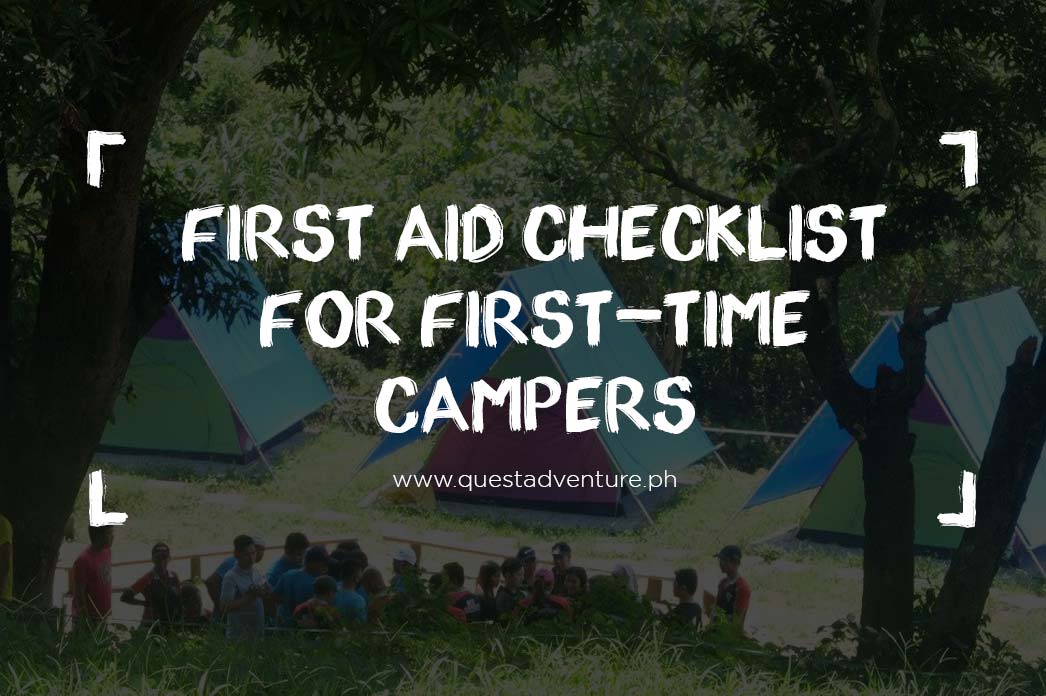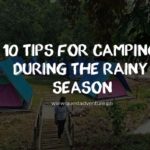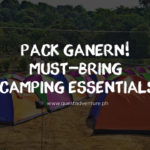
First Aid Checklist for First-Time Campers
Camping is always fun! It’s our chance to get away from the hustle and bustle of our everyday busy lives and appreciate our time with friends or families making memories in the beautiful outdoors.
Preparation is the key for you to fully enjoy the adventures and experiences from this outdoor trip so preparing a checklist is a must. This is a great tool to help with your organization. Your camping list may differ according to the type of camping and activities you have planned, the places you are going, the time of year and the length of your trip but one of the most important and must have things on your list is a first aid kit.
No matter if you’re on the trail, the road, or out at sea, first aid kit is an essential gear. While you enjoy the outdoors here in Quest Adventure Camp, you need not worry about getting rough and dirty during your team building activities. Our staff are well-trained in responding to unexpected situations in the camp.

It is important to have a first aid kit whenever you’re out in the wilderness. A simple fall can bruise and cut a knee, which might not seem that bad at first, but when you add in some dirt, things will change. An allergic reaction to a stinging plant might not feel good, but can be easily remedied with some medication.
See? It is during these relaxing moments at the campsite that we tend to get too excited and somewhat susceptible to those little mishaps, like scrapes, bruises, allergy and minor cuts. So you’ll always want to make sure to bring a well-stocked first aid kit to be prepared for possible accidents during your camping.
But if you are a first-time camper, what should be included in your camping first aid kit? You can actually create your own camping first aid kit with a few items, or buy a basic first aid kit from your local pharmacy and add a few items specific to your camping adventure.
But if you are looking for a complete camping first aid kit checklist, read on, because you found it!
1. First Aid Manual
Every first aid kit must have a first aid manual as this will help you know the basics of first aid like how to treat wounds, sprains, bites, and other common health issues.
2. Adhesive bandages – (Band-aids) of various sizes
These must also be on the top of your list! Adhesive bandages cover and protect the wound and scab from friction, bacteria, damage, and dirt. Thus, the healing process of that body part is less disturbed. Some of these may also have antiseptic properties. Consider purchasing a box of assorted-size bandages and putting a few of each in the kit.
3. Dressings – Gauze pads of multiple sizes, gauze rolls
When adhesive bandages aren’t large enough to cover a wound, it’s crucial to have gauze pads in your first aid kit. Gauze pads can be formed into a bandage or used to absorb blood. Gauze pads come in many sizes and each kit should include an assortment.
4. Medications – Analgesics like Ibuprofen, Antipyretic like Paracetamol or aspirin, anti-diarrheal, antacids, antihistamines.
Ibuprofen suppresses mild pain and reduces swelling. Also, carry paracetamol or aspirin for fever and chills. Antacids and antihistamines might not be lifesavers but these will keep your stomach and skin issues from ruining your trip.
5. Creams – Antibiotic ointment, Burn cream, Anti-fungal cream, Anti-histamine cream, Aloe Vera, tincture of benzoin
Prevent infection by always bringing these creams on the kit. Cuts or burns should be treated with these creams to keep bacteria and fungi out, promote healing, and minimize irritations. But always remember that meds like these should be administered after the injured area has been thoroughly cleaned.
6. Antiseptic – alcohol swabs or povidone iodine
Antiseptic cleaners like alcohol and povidone-iodine, popularly known as Betadine, clean dirt from cuts and scrapes before antibiotic ointment or bandages are placed on the area thus reducing the possible incidence of bacterial or fungal infection. This may be also used to clean other tools like tweezers, needles, etc.
7. Tweezers, needles, safety pins
Use tweezers, needles or safety pins to remove debris such as glass, dirt, splinters or ticks. Just be sure to sterilize this first with alcohol or a lighter before using, unless, it will just add up to your problem as this may be the cause of bacterial entry.
8. Medical Tape – hypoallergenic, micropore
These are used to secure gauze pads or wraps when they are being used as a bandage. This tape is intended not to leave residue behind and usually comes in a long roll.
9. Elastic bandages
These flexible bandages, varying in width from one to six inches, help keep a sprained joint immobile to reduce swelling. These could be wrapped around ankles, knees, wrists, and elbows until you can get to a doctor.
10. Instant ice pack
Health care practitioners recommend icing an injury to prevent swelling so might also want to bring a one-time, instant-use cold pack which does not become cold until the seal on the packaging is broken and the material inside is activated. This type is ideal for basic first aid kits because they don’t require refrigeration.
11. Other important tools
There list of important tools that you might want to bring in camping, like scissors, face mask, tourniquet, gloves, zip-lock bag, lighter, thermometer, whistle and a waterproofed sheet of important emergency contact phone numbers are also recommended to be always present in your camping first aid kit.
Where to get these things?
There are actually two ways to acquire things for your camping first aid kit. First, purchase a pre-made backpacking first aid kit meant for camping. Or purchase a first aid bag, and purchase the items individually.
Remember, you do not need large bottles or amounts of anything. You just need some things that are just enough to get you and your group get out of the wilderness safely without ruining the joyful moments your first camping experience may give you.
Happy camping!








No Comments
Sorry, the comment form is closed at this time.